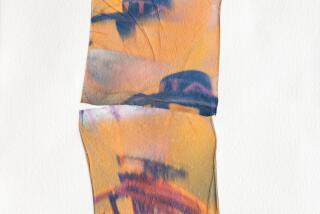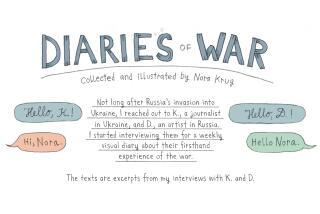Tintin to the Rescue : TINTIN AND THE WORLD OF HERGE An Illustrated History <i> By Benoit Peeters Translated from the French by Michael Farr (A Bulfinch Press Book / Little, Brown and Co.: $45; 161 pp.) </i>
- Share via
Mention Tintin (the comic-strip adventures of) to a group of your pals and at least one will respond like Proust to the madeleine , a matrix of infinitely pleasurable childhood associations resurfacing to suffuse the present moment.
The man responsible for this magic signed himself Herge (reverse the initials of Georges Remi and pronounce them in French, as he did in his native Brussels). The stories were first published serially in periodicals, beginning in the late 1920s. Subsequently reworked and collected into two dozen large-format color albums, they continued to appear until the author-artist’s death in 1983.
Initially a young man’s lark, the oeuvre --there’s no more appropriate word for it--grew in technical aplomb, visual and intellectual complexity, emotional and even philosophic sophistication. Blessedly, it never lost its rare blend of poetic vision and down-to-earth comedy. The humor, rooted equally in personalities and pratfalls, is an acknowledgment of--perhaps a hymn to--life’s perpetual absurdity.
Children and adults have continued to cherish Herge’s creation with a cult-like enthusiasm evidenced by its having been translated into a veritable Berlitz blitz of languages. A number of the most seriously addicted admirers have written about it, in both scholarly and popular forms. (What better way of hanging out in the vicinity of something you adore?) Among these devoted chroniclers is Benoit Peeters, whose “Tintin and the World of Herge,” the English translation of his 1983 work, is this season being distributed in America.
Peeters’ book explores the series album by album, with a brief biographical introduction and a concluding survey of Herge’s wider facility as a commercial artist. Physically, it’s a handsome volume, the sort of thing your coffee table might enjoy receiving for Christmas. Given its ace illustrator, it could hardly fail to please. And the illustrations are not merely decorative but instructive, comprising source materials as well as fascinating glimpses of Tintin editions that preceded the definitive one.
Peeters’ text, alas, is baffling, frustrating, insufficient. As if it were intended for youngsters, it is short and simplified, its content almost entirely bled of controversial or unhappy issues--political, social and emotional matters central to Herge’s life and work. Yet its vocabulary is well beyond the reach of the grade-school crowd. Peeters offers lots of the anecdotal information fans relish, but attempts little penetrating analysis and no overarching view of the Tintinesque universe.
Like the other volumes I’ve read on the subject--the competing, tabloid-style, but more objective study by Harry Thompson, who was denied use of the pictures by Herge’s estate; Numa Sadoul’s intended oral history, bowdlerized and otherwise reworked by the self-protective Herge, but nonetheless illuminating; Thierry Smolderen’s and Pierre Sterckx’s impressionistic biography, and Frederic Soumis’ “Dossier Tintin: Sources, Versions, Themes, Structures,” a monument of finicky detail--like all of these, Peeters’ survey leads you right back to Herge and Tintin, who reward you infinitely better than any of the commentators for your money, time, and contemplation.
Why are the Tintin albums so inviting, so absorbing? Why do they seem, almost like George Herriman’s divine “Krazy Kat,” to possess a unique soul? To my thinking, the narratives--though most dwelt upon by the exegetes--constitute the least powerful of the elements at work. The majority of them combine the kind of improbable, self-perpetuating adventure (largely unhampered by psychological or even logical motivation) with what were, for yesteryear’s bourgeois Belgium, exotic locales: the Congo, America, outer space. The environments of the early stories were sheer cliche--blithely irresponsible; later, through a formative friendship Herge made with a profoundly cultivated Chinese artist, they were scrupulously, even obsessively researched.
In most of the tales, Tintin, the pure-hearted boyish protagonist, takes it upon himself to conquer evil--which, like the Devil himself, has eternal life and a thousand guises--and to rescue or succor the oppressed. (Early in life, it seems, Herge--imbued with a romantically idealistic morality--was inspired by the concept of the “heroic child.”) Ironically, a couple of the chronicles that are considered near-perfect depart from the adventure format: the sublime “Tintin in Tibet,” the most moving of the tales, and “The Castafiore Emerald,” in which “nothing” happens and everyone stays at home. A slew of subtexts save the Tintin stories from frenetic puerility, foremost among them the sly, multifaceted satire quietly inserted for the grown-ups to savor while their offspring are gorging themselves on the life-and-death action.
A far more significant component of Herge’s creation is the cast of characters, which augments in the course of the series, its members, like those of a repertory troupe, comfortingly reappearing in the shifting contexts. Much has been said about the enigmatic Tintin: a prepubescent youth performing a man’s deeds, a personality so deliberately devoid of attributes other than courage, resourcefulness, and optimism that any wishful-thinking reader can project his own more quirky, faulty self right onto him.
In truth, Tintin is an angelic spirit--virtue incarnate--and, as such, requires foils if he’s not to become insufferable. His first is his dog, Snowy, as faithful to his master as his terrier nature demands, but with a decided preference for simple creature comforts and a justly sarcastic view of most human endeavor. As the series progresses, Tintin’s canine significant-other is somewhat supplanted by Captain Haddock, a salty tar whose weakness for alcohol, proneness to accident and growing preference for a serene domestic existence over dangerous exploits are topped only by his much-exercised vocabulary of exotic epithets. Despite his obvious heart of gold, Haddock is quick to anger, pelting the objects of his exasperation with insults such as “illiterate,” “gyroscope,” “paranoiac,” “technocrat,” “waffle iron,” “vivisectionist.”
Apparently an orphan, Tintin gradually acquires an extended “family” that is as mixed a lot as one’s own blood relations. Perhaps its most endearing member is Professor Cuthbert Calculus, a gentle, even pathetic embodiment of the crazed scientist. Inattentive to everyday reality (Calculus assures himself of his condition by being obdurately hard of hearing), he is obsessed by inventions that the world at large regards--sometimes rightly, sometimes wrongly--as quite mad. The group is further augmented by the look-alike detectives Thomson and Thompson, glorious in their pompous, infinite stupidity, their professional and sheer physical ineptness superbly compounded by being cloned and mirror-imaged.
Women hardly figure in Tintin’s universe--it is decidedly presexual--the exception being the overbearing diva Bianca Castafiore, from whose shrill rendition of the Jewel Song there is no escape. She, like the eternal bore, Jolyon Wagg, means no harm, though; the two are merely grotesquely self-absorbed. Villainy is left to a host of colorful if generic “others,” over whom good invariably triumphs. Actually, it is only this predestined happy ending that is patently make-believe, for, despite the reductions and exaggerations required by his genre, Herge is a sharp observer of human nature.
Oddly enough, the most glorious element of the Tintin series--the pictorial--has been underemphasized by Herge’s admirers. This is popular art of the highest order.
Composition, perhaps the greatest of its many strengths, is scrupulously classical. No matter how low-down the subject matter or how chaotic the situation displayed, each frame remains faithful to rigorous principles of order and harmony. (Typically, the balance is the subtle kind of the Impressionists, appropriated from Japanese prints.)
Contrasting with this exquisite repose is the dramatic tempo Herge achieves through a handful of devices sure to keep the reader’s eye and brain alert. Some of them are cinematic: rapidly alternating the point of view from front to back; shifting the distance from which figures and objects are seen from near-microscopic close-up to long-distance panoramas.
The size and shape of the frames are varied too, in exact accordance with their contents: A ringing phone gets a postage stamp’s worth of space; a rocket headed for the moon, a whole page; horizons are slenderly, languorously horizontal. Further excitement--both visceral and aesthetic--is achieved through vertiginous perspectives: When Tintin precipitously crawls across the face of a skyscraper, you feel both the death threat to vulnerable flesh and the severe stony magnificence of the building’s facade.
While the quality of the color varies from album to album, succumbing occasionally to the cheaply and incohesively garish, when it’s good, it can be heavenly. The most memorable effects are achieved through unusual juxtapositions of color--again typical of Japanese art--and, especially, by many small modulations within a restricted palette. The latter device gives Herge’s twilight scenes their tender, haunting atmosphere and lends his nighttime landscapes with silhouetted figures that film noir quality of fear provocatively coupled with beauty.
Anyone who lives through his eyes could find at least a half-dozen more aspects to extol in the Tintin iconography. Perhaps the top candidates are the infinite richness and exactness of detail; the lavish tour-de-force frames into which a complete universe seems to be crammed (my favorite is the aquatic underworld, complete with wrecked ship, in “Red Rackham’s Treasure”); the vehicles that are clearly the inanimate heroes of the series. Cars, ships, trains, planes and finally that rocket to the moon invite you to relish both the ingenious mechanisms that make them go and the sheer visceral thrill of locomotion, preferably at top speed.
It should be emphasized that a substantial part of the credit for this achievement is due to the gifted collaborators who accreted to Herge, some of them acknowledged masters of the comic strip in their own right. But the original impetus--as the reissue of the first, black-and-white versions of the early stories proves--was always Herge’s, and the overall direction remained firmly in his control.
Over the decades, as the world of Tintin grew into an empire with a studio to support it, the effort may have been communal, but the product was not anonymous. As the memoirs confirm, it represents one man’s irresistible vision, based on the fantasies of the boy he was, deepened and often rerouted by the man he became, at once knowingly urbane and innocently exalted.
The series of Tintin books is available in paperback from Joy Street/Little Brown.
More to Read
Sign up for our Book Club newsletter
Get the latest news, events and more from the Los Angeles Times Book Club, and help us get L.A. reading and talking.
You may occasionally receive promotional content from the Los Angeles Times.









